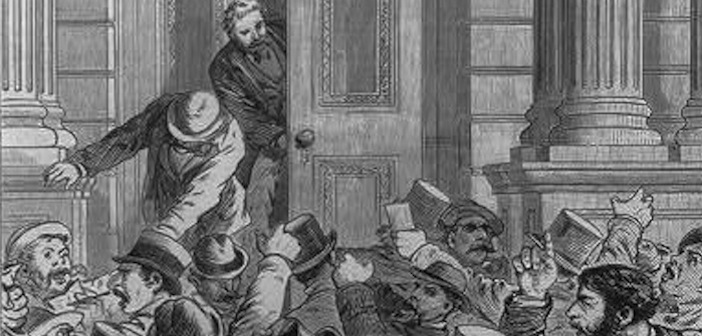
Many Americans remember the Great Depression that left our country in financial ruin during the 1930’s.1 However, many of them are oblivious to the depression that was brought on by the Panic of 1873. Even fewer people are aware of the fact that the Panic of 1873 was dubbed the Great Depression until subsequent years when that title was won over by the decade encompassing the 1930’s.2 The 1930’s Great Depression, as we know it today, was brought on by a crash in the stock market (and various other factors, but mainly the events leading up to Black Tuesday, October 29, 1929).3 The Panic of 1873 had various causes that historians still debate for being the most responsible for the economic slump.

Unlike the Great Depression, the Panic of 1873 was brought on by high risk investments into the railroad building business. The demise of Jay Cooke & Company, the leading investor at the time, started a domino effect that was felt not only in the United States but also in Britain (triggering a severe two-decade long slump).4 The firm led financial efforts during the Civil War, and as a result of that, it became an agent for the federal government. Its promise was to build the second transcontinental railroad. By September 18, 1873, Cooke’s investment firm had declared bankruptcy.
The railroad building business was very risky; investors were essentially pouring their money into building industrial tracks leading to nowhere in hopes that the location would become prime locations for commerce. The leading firm, Jay Cooke & Company, decided to fold; a significant number of companies followed, approximately eighty-nine out of the existing three hundred sixty-four railroad companies.5 The majority of these companies declared bankruptcy within the first two years after Jay Cooke & Company declared bankruptcy, meaning that after having invested most of their monies into the railroad building business, most of those companies would rather take the loss than further invest any more money.6 This in turn caused more problems for the average citizen, because of the economic slump that would ensue.

Because industrialization was so vital for the early development of the United States, it is of no surprise that the railroad business was affected the most by that industrialization. The nation’s development was heavily rooted in the industrious railroad market of the time. Strikes, wage cuts, poor working conditions, less hours, and discrimination plagued the few in the working force. Panic had set in. Men were no longer able to provide for their families as they once did because of the decrease in pay and hours.7 This set up a perfect recipe for employers to take advantage; now they could demand more work for less pay because the unemployment rate was so high (peaking at 14%), so anybody looking for a job would have to take what they could.8 This employment competition led to poorer working conditions and even more discrimination, because any working class citizen would do whatever it took to survive during this time period.

The Panic of 1873 had some disastrous consequences. Aside from the corrupt politics of the time (for example, the Grant Administration Scandals), and the economic tatters the country was left in, the country’s values began to disintegrate as well. One of the most commonly known events, the Haymarket Affair, left seven people dead by a dynamite bomb during a labor demonstration, and many others were severely wounded.9 It seemed like the country would never recover; troops were deployed to various demonstrations as “peace keepers,” but only more violence would ensue. In order for change to occur, new methods would have to be implemented.
The Panic of 1873 never really ended; various factors ultimately led to an upward trend in the economy, and in turn, the growth of the nation again. Investors began to be more cautious with their monies, the government took responsibility for the corruption, and ultimately the country’s morale began to boost. This upward trend led the nation out of its first great depression.
- Alison Cook-Sather and John E Moser, Global Great Depression and the Coming of World War II, U.S. History in International Perspective (Boulder: Routledge, 2015), 8-9. ↵
- Francois Furstenberg, “What history teaches us about the welfare state,” The Washington Post, July 1, 2011. ↵
- Cook-Sather and Moser, Global Great Depression, 51. ↵
- Alan Brinkley, American History, 15th ed., vol. 2: from 1865 (2 Penn Plaza, New York, NY 10121: McGraw Hill Education, 2015), 413. ↵
- Francois Furstenberg, “What history teaches us about the welfare state,” The Washington Post, July 1, 2011. ↵
- John M. Lubetkin, Jay Cooke’s Gamble: The Northern Pacific Railroad, the Sioux, and the Panic of 1873 (Norman:University of Oklahoma Press, 2014), 5, 15. ↵
- Hans Rosenberg, “Political And Social Consequences Of The Great Depression Of 1873‐1896 in Central Europe,” The Economic History Review 13, no. 1‐2 (1943): 69. ↵
- Rosenberg, “Political and Social Consequences of the Great Depression,” 60. ↵
- “Ulysses S. Grant – Part One: Warrior,” American Experience, directed by Adriana Bosch (Arlington, Virginia: WGBH, 2005), DVD. ↵
Tags from the story
Depression of 1873